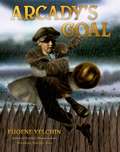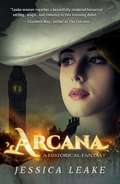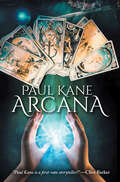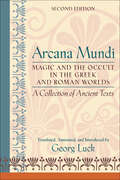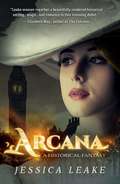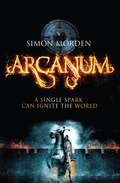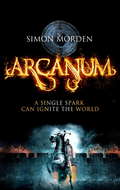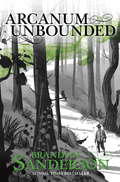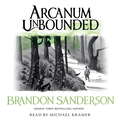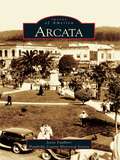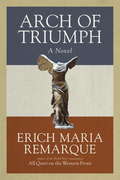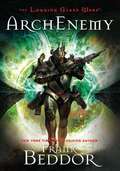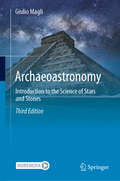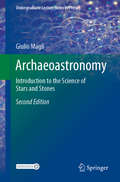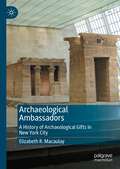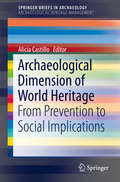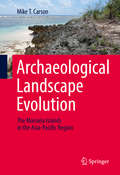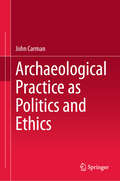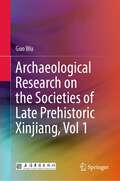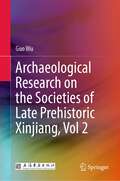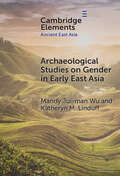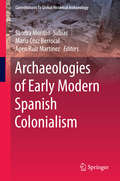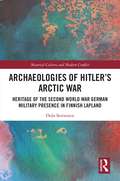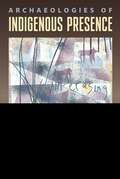- Table View
- List View
Arcady's Goal
by Eugene YelchinWhen twelve-year-old Arcady is sent to a children's home after his parents are declared enemies of the state in Soviet Russia, soccer becomes a way to secure extra rations, respect, and protection but it may also be his way out if he can believe in and love another person--and himself.
Arcana
by Jessica LeakeA romantic, suspenseful, genre-bending debut set in Edwardian London.Amid the sumptuous backdrop of the London season in 1905, headstrong Katherine Sinclair must join the ranks of debutantes vying for suitors. Unfortunately for Katherine, she cannot imagine anything more loathsome--or dangerous. To help ease her entrance into society, Katherine's family has elicited the assistance of the Earl of Thornewood, a friend and London's most eligible bachelor, to be her constant companion at the endless fetes and balls. But upon her arrival in London, Katherine realizes there will be more to this season than just white gowns and husband hunting.Through her late mother's enchanted diary, Katherine receives warning to keep hidden her otherworldly ability to perform arcana, a magic fueled by the power of the sun. Any misstep could mean ruin--and not just for her family name. The Order of the Eternal Sun is everywhere--hunting for those like her, able to feed on arcana with only a touch of the hand.But society intrigue can be just as perilous as the Order. The machinations of the fashionable elite are a constant threat, and those who covet Katherine's arcana, seeking the power of her birthright, could be hiding behind the façade of every suitor--even the darkly handsome Earl of Thornewood.With so much danger and suspicion, can she give her heart to the one who captivates her, or is he just another after her power?
Arcana
by Paul Kane"Arcana is a hugely entertaining read, a real rollercoaster ride of ups and downs that keep the pages turning until the very end, and another work of high quality from this prolific author.&”—Starburst Magazine In an alternate world where real magic exists, its practitioners are hunted down by police officers called M-forcers. But some groups are fighting back! Callum McGuire is a new M-forcer who once worked the quiet streets of London. As an orphan, Callum has been brought up to believe that all magic is evil, but the more he sees of The M-forcers&’ cruel methods (implemented by General Nero Stark, and his second-in-command Sherman Pryce), the more he begins to question whether or not they are right. And when he unwittingly encounters a member of the rebel group called Arcana, he&’s introduced to their world and realises that nothing will ever be the same again. Join award-winning and bestselling author Paul Kane (the sell-out phenomenon Sherlock Holmes and the Servants of Hell, the Hooded Man series, and the bestselling Before) as he shows you a kind of magic you&’ve never seen…
Arcana Mundi: Magic and the Occult in the Greek and Roman Worlds
by Georg LuckDiscover a different way to see classical civilization in this collection of ancient Greek and Roman texts on magic and the occult.Magic, miracles, daemonology, divination, astrology, and alchemy were the arcana mundi, the “secrets of the universe,” of the ancient Greeks and Romans. In this path-breaking collection of Greek and Roman writings on magic and the occult, Georg Luck provides a comprehensive sourcebook and introduction to magic as it was practiced by witches and sorcerers, magi and astrologers, in the Greek and Roman worlds.In this new edition, Luck has gathered and translated 130 ancient texts dating from the eighth century BCE through the fourth century CE. Thoroughly revised, this volume offers several new elements: a comprehensive general introduction, an epilogue discussing the persistence of ancient magic into the early Christian and Byzantine eras, and an appendix on the use of mind-altering substances in occult practices. Also added is an extensive glossary of Greek and Latin magical terms.In Arcana Mundi Georg Luck presents a fascinating?and at times startling?alternative vision of the ancient world. “For a long time it was fashionable to ignore the darker and, to us, perhaps, uncomfortable aspects of everyday life in Greece and Rome,” Luck has written. “But we can no longer idealize the Greeks with their “artistic genius” and the Romans with their “sober realism.” Magic and witchcraft, the fear of daemons and ghosts, the wish to manipulate invisible powers?all of this was very much a part of their lives.”“An excellent translation of ancient texts on the subject, but it’s a lot more than that. It’s a glimpse into the minds of the everyday people of the times and what made them turn, what made them stop, what made them look over their shoulders.” —Courier-Gazette,(Rockland, Maine)“No one currently at work in ancient magic or related fields can remotely compare with Luck for the breadth and profundity of his knowledge of the literary texts . . . or for the humility and lightness of touch with which he conveys his scholarship.” —Daniel Ogden, author of Magic, Witchcraft, and Ghosts in the Greek and Roman Worlds
Arcana: A Novel of the Sylvani (Novels of the Sylvani #1)
by Jessica Leake"Leake weaves together a beautifully rendered historical setting, magic and romance in this stunning debut. " --Elizabeth May, author of The Falconer Amid the sumptuous backdrop of the London season in 1905, headstrong Katherine Sinclair must join the ranks of debutantes vying for suitors. Unfortunately for Katherine, she cannot imagine anything more loathsome--or dangerous. To help ease her entrance into society, Katherine’s family has elicited the assistance of the Earl of Thornewood, a friend and London’s most eligible bachelor, to be her constant companion at the endless fetes and balls. But upon her arrival in London, Katherine realizes there will be more to this season than just white gowns and husband hunting. Through her late mother’s enchanted diary, Katherine receives warning to keep hidden her otherworldly ability to perform arcana, a magic fueled by the power of the sun. Any misstep could mean ruin--and not just for her family name. The Order of the Eternal Sun is everywhere--hunting for those like her, able to feed on arcana with only a touch of the hand. But society intrigue can be just as perilous as the Order. The machinations of the fashionable elite are a constant threat, and those who covet Katherine’s arcana, seeking the power of her birthright, could be hiding behind the facade of every suitor--even the darkly handsome Earl of Thornewood. With so much danger and suspicion, can she give her heart to the one who captivates her, or is he just another after her power?
Arcanum
by Simon MordenRome was the center of the most powerful empire the world had ever seen, but that didn't stop it falling to Alaric the Goth, his horde of barbarian tribesmen and their wild spell-casting shamans. Having split the walls with their sorcery and slaughtered the inhabitants with their axes, the victors carved up the empire into a series of bickering states which were never more than an insult away from war.A thousand years later, and Europe has become an almost civilized place. The rulers of the old Roman palatinates confine their warfare to the short summer months, trade flourishes along the rivers and roads, and farming has become less back-breaking, all due to the magic, bestowed by gods, that infuses daily life.Even the barbarians' gods have been tamed: where once human sacrifices poured their blood onto the ground, there are parties and picnics, drinking and singing, fit for decent people and their children.But it looks like the gods are going to have the last laugh before they slip quietly into ill-remembered obscurity...
Arcanum
by Simon MordenThe kingdom of Carinthia is rich, powerful and undefeated. A thousand years ago, its ancestors were the spell-wielding northern tribes who crushed the Roman Empire. Their legendary hexmasters can destroy whole armies and turn battlefields into fiery lakes of lava.Magic is Carinthia's wealth, protection and way of life. But the age of magic is dying. Some would do anything to see it return: any act, no matter how terrible, is justified, so long as the hexmasters can still protect their homeland.The kingdom is poised between order and chaos - and the smallest spark is the difference between disaster and triumph.ARCANUM is powerful new epic fantasy from an award-winning author.
Arcanum Unbounded: The Cosmere Collection
by Brandon SandersonWelcome to New York Times and Sunday Times bestseller Brandon Sanderson's first collection of short fiction.These wonderful works, originally published individually, have been collected for the first time and convey the true expanse of the Cosmere. Telling the exciting tales of adventure Sanderson fans have come to expect, Arcanum Unbounded include the Hugo Award-winning novella 'The Emperor's Soul', an excerpt from the graphic novel 'White Sand', and the never-before-published Stormlight Archive novella 'Edgedancer'.The collection will include nine works in all:'Edgedancer' (Stormlight Archive)'The Hope of Elantris' (Elantris)'The Eleventh Metal' (Mistborn)'The Emperor's Soul' (Elantris)'Allomancer Jak and the Pits of Eltania' (excerpt; Mistborn)'White Sand' (excerpt; Taldain)'Shadows for Silence in the Forests of Hell' (Threnody) 'Sixth of Dusk' (First of the Sun)'Mistborn: Secret History' (Mistborn)This superb collection also includes essays and illustrations which offer an insight into the numerous worlds in which the stories are set.
Arcanum Unbounded: The Cosmere Collection
by Brandon SandersonWelcome to New York Times and Sunday Times bestseller Brandon Sanderson's first collection of short fiction.These wonderful works, originally published individually, have been collected for the first time and convey the true expanse of the Cosmere. Telling the exciting tales of adventure Sanderson fans have come to expect, Arcanum Unbounded include the Hugo Award-winning novella 'The Emperor's Soul', an excerpt from the graphic novel 'White Sand', and the never-before-published Stormlight Archive novella 'Edgedancer'.The collection will include nine works in all:'Edgedancer' (Stormlight Archive)'The Hope of Elantris' (Elantris)'The Eleventh Metal' (Mistborn)'The Emperor's Soul' (Elantris)'Allomancer Jak and the Pits of Eltania' (excerpt; Mistborn)'White Sand' (excerpt; Taldain)'Shadows for Silence in the Forests of Hell' (Threnody) 'Sixth of Dusk' (First of the Sun)'Mistborn: Secret History' (Mistborn)This superb collection also includes essays and illustrations which offer an insight into the numerous worlds in which the stories are set.
Arcata (Images of America)
by Humboldt County Historical Society Jessie FaulknerArcata, a bright jewel surrounded by the redwood forested hills of northern Humboldt Bay, was once the territory of the Wiyot Indians. The tribe only barely survived massacres and relocation after a town was founded there in 1850, a supply point for gold seekers at nearby mines. That town soon evolved into a center for a thriving lumber industry that fed sawmills and a barrel factory, and dairies that prospered on the pastoral Arcata Bottom. Home to Humboldt State University and the much loved Humboldt Crabs baseball team, Arcata is attracting new businesses, industries, and national attention for its innovative Arcata Marsh public works project.
Arch Of Bone
by Jane Yolen Ruth SandersonContinuing the story from where Moby Dick left off, this compelling boyhood adventure, penned by beloved author Jane Yolen (Owl Moon), hearkens to timeless coming of age tales of yore. Lovingly illustrated by Ruth Sanderson, the journey of a boy and his dog comes to life on the page, renewing the joy of a classic tale.
Arch of Triumph
by Erich Maria Remarque Denver Lindley Walter SorellThe evocative story of a man without a country, Arch of Triumph is a World War II-era classic from the author of All Quiet on the Western Front. It is 1939. Despite a law banning him from performing surgery, Ravic--a German doctor and refugee living in Paris--has been treating some of the city's most elite citizens for two years on the behalf of two less-than-skillful French physicians. Forbidden to return to his own country, and dodging the everyday dangers of jail and deportation, Ravic manages to hang on--all the while searching for the Nazi who tortured him back in Germany. And though he's given up on the possibility of love, life has a curious way of taking a turn for the romantic, even during the worst of times. "The world has a great writer in Erich Maria Remarque. He is a craftsman of unquestionably first rank, a man who can bend language to his will. Whether he writes of men or of inanimate nature, his touch is sensitive, firm, and sure."--The New York Times Book ReviewFrom the Trade Paperback edition.
ArchEnemy (The Looking Glass Wars #3)
by Frank BeddorDiscover the fate of Wonderland -- and imagination itself -- in this riveting conclusion to "The Looking Glass Wars" trilogy. The Heart Crystal's power has been depleted, and Imagination along with it. The people of Wonderland have all lost their creative drive, and most alarmingly, even Queen Alyss is without her powers. There is some comfort in the fact that the vicious Redd Heart seems to be similarly disabled. Amazingly, she is attempting to team up with her enemy, Alyss, in order to reclaim Wonderland from King Arch. Alyss might have no choice but to accept Redd's overtures, especially when she begins to receive alarming advice from the caterpillar oracles.
Archaeoastronomy: Introduction to the Science of Stars and Stones
by Giulio MagliThis book provides the first comprehensive, easy-to-read, and up-to-date account of the fascinating discipline of archaeoastronomy, in which the relationship between ancient constructions and the sky is studied to gain a better understanding of the ideas of the architects of the past and their religious and symbolic worlds. The book is divided into three sections. The first section discusses in detail the fundamentals of archaeoastronomy, including the celestial coordinates, the apparent motion of the sun, moon, stars, and planets, observation of celestial bodies at the horizon, the use of astronomical software in archaeoastronomy, and current methods for making and analyzing measurements . The second part explores the past relations between astronomy and people, power, the afterworld, architecture, and landscape The final section reviews what archaeoastronomy can now tell us about the nature and purpose of such sites and structures as Stonehenge, the Pyramids of Giza, Chichen Itza, the Angkor Temples, the Campus Martius, Machu Picchu and the Valley of the Temples of Agrigento. Additionally, it provides a set of exercises that can be performed using non-commercial free software, e.g., Google Earth and Stellarium, and that will equip readers to conduct their research. This book is an ideal introduction to what has become a wide-ranging multidisciplinary science. This newly revised edition includes the most recent research on Stonehenge, ancient Japan, and other sites worldwide.
Archaeoastronomy: Introduction to the Science of Stars and Stones (Undergraduate Lecture Notes in Physics)
by Giulio MagliThis is a second edition of a textbook that provides the first comprehensive, easy-to-read, and up-to-date account of the fascinating discipline of archaeoastronomy, in which the relationship between ancient constructions and the sky is studied in order to gain a better understanding of the ideas of the architects of the past and of their religious and symbolic worlds. The book is divided into three sections, the first of which explores the past relations between astronomy and people, power, the afterworld, architecture, and landscape. The second part then discusses in detail the fundamentals of archaeoastronomy, including the celestial coordinates; the apparent motion of the sun, moon, stars, and planets; observation of celestial bodies at the horizon; the use of astronomical software in archaeoastronomy; and current methods for making and analyzing measurements. The final section reviews what archaeoastronomy can now tell us about the nature and purpose of such sites and structures as Stonehenge, the Pyramids of Giza, Chichen Itza, the Angkor Temples, the Campus Martius, and the Valley of the Temples of Agrigento. In addition, it provides a set of exercises that can be performed using non-commercial free software, e.g., Google Earth and Stellarium, and that will equip readers to conduct their own research. This new edition features a completely new chapter on archaeoastronomy in Asia and an “augmented reality” framework, which on the one hand enhances the didactic value of the book using direct links to the relevant sections of the author’s MOOC (online) lessons and, on the other, allows readers to directly experience – albeit virtually –many of the spectacular archaeological sites described in the book. This is an ideal introduction to what has become a wide-ranging multidisciplinary science.
Archaeological Ambassadors: A History of Archaeological Gifts in New York City
by Elizabeth R. MacaulayThis book investigates why nations with rich archaeological pasts like Egypt, Greece, and Jordan gave important antiquities—often unique, rare, and highly valued monuments—to New York City, New York Institutions, and the United States from 1879 to 1965. In addition to analyzing the givers’ motivations, the author examines why New Yorkers and Americans coveted such objects. The book argues that these gifted antiquities function as archaeological ambassadors and that the objects given were instruments of cultural diplomacy. These gifts sought to advance the goals of Egypt, Greece, and Jordan—all states that had rich cultural and archaeological heritages—with the United States, once an ascendent nation and then a global superpower, to strengthen cultural, economic, and political relations.
Archaeological Dimension of World Heritage: From Prevention to Social Implications (SpringerBriefs in Archaeology)
by Alicia CastilloThis volume presents case studies from around the world aiming to serve as a hands-on book for management and treatment of archaeological World Heritage properties. It comprises not only sites inscribed as World Heritage due to their archaeological character but also World Heritage properties where the analysis of their archaeological dimension provides a deeper and better understanding of the assets and includes the potential for disseminating this knowledge. The book has an important practical value, since all the works presented here illustrate - with practical examples, the best and most appropriate ways to manage World Heritage properties. The aim of the heritage managers at these World Heritage sites is to improve conservation and increase understanding and communication in such a way that the communities living in those sites or who earn a livelihood from them can be positively affected by these initiatives. The book presents exemplary models of heritage management in World Heritage properties-an issue not treated in depth up to now and Best Practices in this management. Therefore, this volume becomes a new, original source presenting model strategies to be followed by other initiatives in order to improve the consideration and treatment of the most outstanding valued sites considered by UNESCO.
Archaeological Landscape Evolution: The Mariana Islands in the Asia-Pacific Region
by Mike T. CarsonLandscapes have been fundamentalto the human experience world-wide and throughout time, yet how did we as humanbeings evolve or co-evolve with our landscapes? By answering this question, we can understand our place in the complex,ever-changing world that we inhabit. Thisbook guides readers on a journey through the concurrent processes of change inan integrated natural-cultural history of a landscape. While outlining the general principles forglobal application, a richly illustrated case is offered through the MarianaIslands in the northwest tropical Pacific and furthermore situated in a largerAsia-Pacific context for a full comprehension of landscape evolution atvariable scales. The author examines whathappened during the first time when human beings encountered the world's RemoteOceanic environment in the Mariana Islands about 3500 years ago, followed by acontinuous sequence of changing sea level, climate, water resources, forestcomposition, human population growth, and social dynamics. This book provides a high-resolution andlong-term view of the complexities of landscape evolution that affect all of ustoday.
Archaeological Practice as Politics and Ethics
by John CarmanThis book is of relevance to all archaeologists and all others concerned with how an interest in the past impacts on the present. This book explores the manner in which archaeology as a discipline and a field of endeavour contributes to the modern world. The focus throughout the book is on practices - the range of different things that archaeologists do and how they do and have done it in order to explore the field as a distinctive aspect of social practice over time. It also concerns the structures – social, political, economic, professional, philosophical – in which archaeology is performed and the consequences for the discipline and its practitioners. Throughout there is a concern especially with archaeology as a field of political and ethical decision-making, aspects well recognised by practitioners but rarely emphasised. The book both asks and answers questions about the perception of archaeology from both within and outside the field. The book draws widely on previous work by the author and others – looking at the techniques of the field, the people involved, the political and social impacts both on and by the field. In doing so it seeks to bring these different perspectives together to create a more holistic idea of what archaeology is, has been, and could be. The book is offered to those outside the field as a justification for archaeology – a field coming under increasing pressure from those who consider it (as so many humanities and social science disciplines) as an expensive luxury.
Archaeological Research on the Societies of Late Prehistoric Xinjiang, Vol 1
by Guo WuThis book presents cutting-edge archaeological materials from Xinjiang, from the Bronze Age to the early Iron Age. Through a systematic topological study of major archaeological cemeteries and sites, it establishes chronologies and cultural sequences for three main regions in Xinjiang, namely the circum-Eastern Tianshan region, the circum-Dzungarian Basin region and the circum-Tarim Basin region. It also discusses the origins and local variants of prehistoric archaeological cultures in these regions and the mutual relationships between them and neighboring cultures.By doing so, the book offers a panoramic view of the socio-cultural changes that took place in prehistoric Xinjiang from pastoral-agricultural societies to the mobile nomadic-pastoralist states in the steppe regions and the agricultural states of the oasis, making it a must-read for researchers and general readers who are interested in the archaeology of Xinjiang.
Archaeological Research on the Societies of Late Prehistoric Xinjiang, Vol 2
by Guo WuThis book presents cutting-edge archaeological materials from Xinjiang, from the Bronze Age to the early Iron Age. Through a systematic topological study of major archaeological cemeteries and sites, it establishes chronologies and cultural sequences for three main regions in Xinjiang, namely the circum-Eastern Tianshan region, the circum-Dzungarian Basin region and the circum-Tarim Basin region. It also discusses the origins and local variants of prehistoric archaeological cultures in these regions and the mutual relationships between them and neighboring cultures.By doing so, the book offers a panoramic view of the socio-cultural changes that took place in prehistoric Xinjiang from pastoral-agricultural societies to the mobile nomadic-pastoralist states in the steppe regions and the agricultural states of the oasis, making it a must-read for researchers and general readers who are interested in the archaeology of Xinjiang.
Archaeological Studies on Gender in Early East Asia (Elements in Ancient East Asia)
by Mandy Jui-man Wu Katheryn M. LinduffGendered archaeology in Asia has been studied by archaeologists since the 1990s and scholars have posed questions such as the role and construction of gendered identities in ancient societies. In this Element, the authors review secondary literature, report on to what stage the research has evolved, evaluate methodologies, and use the concept of networking to examine the issues across East Asia, including China, Mongolia, Korea, Japan, and Taiwan. Interestingly, those literatures are not entirely parallel with each other – the authors found, for example, that archaeological investigation was largely bound by national guidelines, by local intellectual traditions, and by changing historiographic interpretations of past events, as well as funding. The complexion of recent studies on gender and archaeology in Asia has often been focused on providing a framework for a grand narrative of each national 'civilization' as the emergence of institutional political structures, including traditional values placed on men and women.
Archaeologies of Early Modern Spanish Colonialism (Contributions To Global Historical Archaeology)
by Sandra Montón-Subías María Cruz Berrocal Apen Ruiz MartínezArchaeologies of Early Modern Spanish Colonialism illustrates how archaeology contributes to the knowledge of early modern Spanish colonialism and the "first globalization" of the 16th and 17th centuries. Through a range of specific case studies, this book offers a global comparative perspective on colonial processes and colonial situations, and the ways in which they were experienced by the different peoples. But we also focus on marginal "unsuccessful" colonial episodes. Thus, some of the papers deal with very brief colonial events, even "marginal" in some cases, considered "failures" by the Spanish crown or even undertook without their consent. These short events are usually overlooked by traditional historiography, which is why archaeological research is particularly important in these cases, since archaeological remains may be the only type of evidence that stands as proof of these colonial events. At the same time, it critically examines the construction of categories and discourses of colonialism, and questions the ideological underpinnings of the source material required to address such a vast issue. Accordingly, the book strikes a balance between theoretical, methodological and empirical issues, integrated to a lesser or greater extent in most of the chapters.
Archaeologies of Hitler’s Arctic War: Heritage of the Second World War German Military Presence in Finnish Lapland (Material Culture and Modern Conflict)
by Oula SeitsonenThis book discusses the archaeology and heritage of the German military presence in Finnish Lapland during the Second World War, framing this northern, overlooked WWII material legacy from the nearly forgotten Arctic front as ‘dark heritage’ – a concrete reminder of Finns siding with the Nazis – and as polluting ‘war junk’ that ruins the ‘pristine natural beauty’ of Lapland’s wilderness. The scholarship herein provides fresh perspectives to contemporary discussions on heritage perception and ownership, indigenous rights, community empowerment, relational ontologies, and the ongoing worldwide refugee crisis.
Archaeologies of Indigenous Presence
by Lee M. Panich Tsim D. SchneiderHighlighting collaborative archaeological research that centers the enduring histories of Native peoples in North AmericaChallenging narratives of Indigenous cultural loss and disappearance that are still prevalent in the archaeological study of colonization, this book highlights collaborative research and efforts to center the enduring histories of Native peoples in North America through case studies from several regions across the continent.The contributors to this volume, including Indigenous scholars and Tribal resource managers, examine different ways that archaeologists can center long-term Indigenous presence in the practices of fieldwork, laboratory analysis, scholarly communication, and public interpretation. These conversations range from ways to reframe colonial encounters in light of Indigenous persistence to the practicalities of identifying poorly documented sites dating to the late nineteenth century.In recognizing Indigenous presence in the centuries after 1492, this volume counters continued patterns of unknowing in archaeology and offers new perspectives on decolonizing the field. These essays show how this approach can help expose silenced histories, modeling research practices that acknowledge Tribes as living entities with their own rights, interests, and epistemologies.
